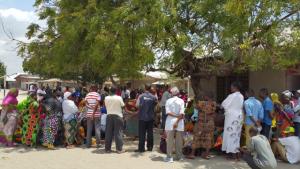WHO steps up response to stop severe cholera outbreak in Tanzania
Dar es Salaam, 10 December 2015 – Tanzania's cholera outbreak, which began in late August 2015, has progressively spread to more than half of country's regions, affecting thousands of people. Months into the response, local capacities and resources are overstretched; prompting the World Health Organization (WHO) to classify the outbreak an organization-wide priority, enabling it to deploy additional resources to contain the disease’s spread.
As of 8 December, 10 412 cases and 159 deaths have been reported in 21 of the country’s 30 regions. Dar es Salaam, the commercial capital with a population of 4.4 million, accounts for 44% of all people who have contracted cholera. The cumulative number of people with cholera has doubled between the end of October and end of November 2015. Zanzibar has reported 572 cases and 6 deaths.
“The current outbreak is unusual because of its vast geographical spread within a short period of time,” says WHO Representative to Tanzania, Dr Rufaro Chatora. “The beginning of the rainy season may make it harder to contain outbreak. We are very concerned about the health and well-being of the people affected, especially women and girls, as they are more exposed due to household chores involving water collection, handling and storage practices at home.”
The worsening cholera threat is worrisome with forecasts for the El Niño weather pattern becoming the strongest on record. El Niño is usually associated with extreme weather events such as floods and drought. In 1997 similar meteorological El Niño conditions was associated with the biggest cholera epidemic with more than 40 000 people contracting the disease.
Scaling up response to stem the outbreak
Ending the outbreak and preventing its spread beyond Tanzania's borders is a high priority for WHO. To do this, a National Cholera Task Force (CTF) has been established comprising the Ministry of Health and Social Welfare (MoHSW), United Nations partners and health partners. The CTF has been established to plan, coordinate and help national authorities implement the response.
Coupled with this, WHO is working to help curb the outbreak and have deployed a team of public health experts from its WHO Inter-country Support Team (IST) for Eastern and Southern Africa, the WHO Regional Office for Africa and WHO Headquarters in Geneva. Also, field investigation teams have also been deployed to the affected areas to strengthen surveillance, investigation, case findings and standardize case management.
Through these actions, WHO is supporting the multisectoral response through strengthened logistics, surveillance, laboratory diagnosis, case management, and social mobilization, and water, sanitation and hygiene (WASH) interventions at national and sub-national levels.
To ensure timely access to treatment, 82 cholera treatment centres (CTCs) have been set up in 22 regions. WHO has also procured and distributed additional cholera kits, medicines as well as medical supplies.
A social mobilization response plan, training manual for orientation of community volunteers, Training of Trainers (ToT) for Ward Health officers, and information, education and communication (IEC) materials have disseminated widely to strengthen the communities response to interrupt transmission of the outbreak.
Results from a water quality survey reveal that the cholera outbreak’s source has been contaminated water from shallow and deep wells, including tap water. Poor hygienic practices and a lack of sanitation facilities in poor households are additional factors. To address this situation, national and sub-national water authorities are working to improve the quality and safety of the water supply in affected areas through chlorination, periodic monitoring of water quality and hygiene promotion.
WHO advice
WHO does not recommend any travel or trade restrictions to Tanzania based on the current information available.




